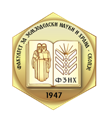QUALITY OF EGG FOR CONSUMPTION FROM DIFFERENT PRODUCERS IN THE MARKETS IN R. MACEDONIA: 2. HOUGH UNITS AND YOLK COLOR
Keywords:
brands, eggs for consumption, markets, Hough units, yolk colorAbstract
Eggs from 7 different brands offered to the supermarket chains in R. Macedonia were tested for meeting the minimum quality requirements defined by the Law. Egg size (egg weight in g) as well as internal quality traits (Hough Units that unbiased expressed egg “freshness” and Yolk color expressed as Roche leader scale from 1-14) were analyzed on 140 eggs. Each group was randomly represented by 10 M-weight class and 10 L-weight class eggs from each of the 7 brands, purchased directly from the supermarket shelf and analyzed the same day after the purchasing. Egg quality was analyzed in the Laboratory for control of the marketing quality of eggs at the Institute for animal biotechnology on the Faculty of agricultural science and food, using computerized equipment for measuring egg internal quality (Egg Multi Tester EMT 5200, Robotmation Co. Ltd., Tokyo, Japan). Eggs from analyzed brands in general meat the required marketing standards in respect to the
analyzed parameters: egg albumen height or freshness (average = 61.56 and 58.75 Hough Units) and yolk color (average = 12.48 and 12.28 units of Roche scale) for L and M weight class, respectively. Only eggs from brand No. 4 does not fulfill the minimum required marketing standards in respect of the Hough Units (42.49 and 40.89 Hough Units) for M and L weight class, respectively. Additionally, eggs from brand No. 5 have average value below (51.95 Hough Units) the minimal required standard for freshness of 55 Hough units defined in the Law for quality of agricultural products and average weight for L class lower (62.04g) than the minimum requirement of 63g for this weight class.
References
Baumgartner J, Benková J, Peškovicová D (2007): Effect of line, age and individuality on yolk cholesterol content and some other egg quality traits in Leghorn type yolk cholesterol selected hens. XVIII European Symposium on the quality of poultry meat and XII European Symposium on the quality of eggs and egg products, September 2 - 5. Prague, pp. 35-36.
Hamilton R.M.G., Hollands K.G., Voisey B.W., Grunder A.A. (1979): Relationship between eggshell quality and shell breakage and factors that affect shell breakage in the field: a review. World’s Poultry Science Journal 35, 177-190.
Johnston SA, Gous RM (2007): Modelling the changes in the proportions of the egg components during a laying cycle. Br Poult Sci 48: 347-353.
Kocevski D., Nikolova N., Kuzelov A. (2011):The influence of strain and age on some egg quality parameters of commercial laying hens. Biotechnology in Animal Husbandry, Belgrade - Zemun, Serbia. Vol. 27 (4), p. 1649 - 1658.
Kocevski D., Nikolova N., Bunevski G., Džabirski V., Vukovid V., Porču K. (2015): Quality of eggs for consumption from different producers in the markets in R. Macedonia. 1: Egg mass and egg shell strength. Macedonian Journal of animal science. Vol.5 (2), p.63-68
Kralik Zlata, Gordana Kralik, Manuela Grcevic, Z. Skrtic, Ewa Biazik (2012): Comparison of consumable eggs quality of different producers, Krmiva 54, Zagreb 1:17-21.
Law for quality of agricultural products, Chapter 1, „Market organization“, Part 4 „Market organization for poultry meat and eggs“ (Official Gazette of R. Macedonia, 2010/140, 21.10.2010.
Law for quality of agricultural products (Addition of Low Official Gazette of R. Macedonia 2011/53, 14.04.2011 and Official Gazette of R. Macedonia 2012/55, 03.05.2012)
Ledvinka Z, Tůmová E, Arent E, Holoubek J, Klesalová L (2000): Egg shell quality in some whiteegg and brown-egg cross combinations of dominant hens. Czech J Anim Sci 45: 285-288.
Management Guide Commercial Layers (2007): http://www.hendrix-genetics.com.
Nikolova Nedeljka, Pavlovski Zlatica, Miloševid N., Waehner M. (2008). Influence of heat stress and age on the percentage of calcium carbonate in eggshell and the percentage of broken and cracked eggs, submitted: 12.2007 in: Archives of Animal Breeding, Germany, Dummerstorf 51 (2008) 4, p. 389 - 396.
Oloyo RA 2003: Effect of age on total lipid and cholesterol of hen eggs. Indian J Anim Sci 73: 94-96.
Peebles ED, Zumwalt CD, Doyle SM, Gerard PD, Latour MA, Boyle CR, Smith TW 2000: Effects of breeder age and dietary fat source and level on broiler hatching egg characteristics. Poult Sci 79:698-704.
Pavlovski Zlatica, Zdenka Skrbic, R. Cmiljanic, M. Lukic (2007): Sistem garantovanog kvaliteta jaja u odnosu na propise EU i zahteve potrosaca. Savremena poljoprivreda, Novi Sad, Srbija, Vol. 56, 1-2 (2007) str. 75-82.
Rizzi C, Chiericato GM (2005): Organic farming production. Effect of age on the productive yield and egg quality of hens of two commercial hybrid lines and two local breeds. Ital J Anim Sci 4: 160-162.
Roberts J.R. (2004): Factors Affecting Egg Internal Quality and Egg Shell Quality in Laying Hens. Journal of Poultry Science. 41:161-177.
Rulebook for the manner of marking of eggs for selling and eggs for incubation, marks and usage of marks (Official Gazette of R. Macedonia 2011/35, 22.03.2011).
Sekeroglu, A., E. Altuntas (2009): Effects of egg weight on egg quality characteristics. Journal of the Science of Food and Agriculture, 89, (3): 379-383.
Seuss-Baum, I. (2005): Nutritional evolution of egg components. XIth European Symposium on the Quality of Eggs and Egg Products Doorwerth, The Netherlands, 23-26 May (CD Symposium Proceedings).
Silversides FG, Scott TA (2001): Effect of storage and layer age on quality of eggs from two linesof hens. Poult. Sci. 80: 1240-1245.
Van den Brand H, Parmentier HK, Kemp B (2004): Effects of housing system (outdoor vs. cages) and age of laying hens on egg characteristics. Br Poult Sci 45: 745-752.
Zemková Ľ, Simeonovová J, Lichovníková M, Somerlíková K 2007: The effects of housing systems and age of hens on the weight and cholesterol concentration of the egg. Czech J Anim Sci 52: 110-115.



